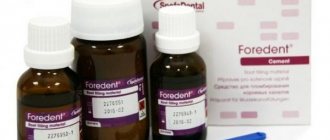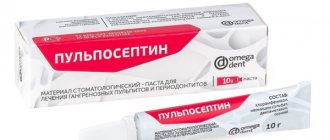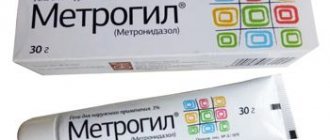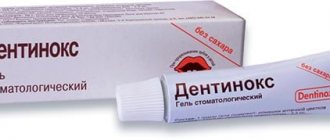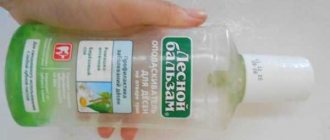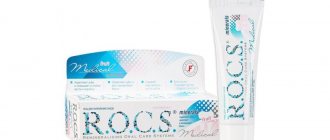Since childhood, people have been afraid of visiting the dental office and try to avoid such an event.
Modern dentistry has the ability to minimize the discomfort that creates fear with the help of specially developed painkillers.
Ultracain is considered one of these. The product reduces the pain inherent in the dental treatment process.
Drug review
Ultracaine is a transparent and colorless substance of a local anesthetic drug, odorless. The active ingredient is Articaine. Pharmaceutical companies produce the product in ampoules of 5 ml and 20 ml. The cardboard package contains 5 ampoules.
In dentistry, the substance is used as a local anesthetic. The injection can prevent the passage of impulses into nerve cells and prevent the occurrence of pain.
Composition and characteristics
1 ml. the solution contains articaine hydrochloride (4%) and epinephrine (adrenaline hydrogen tartrate). Articaine is a 5th generation analgesic that combines strong pain relief and safety for the patient’s health.
According to research, the effect of Articaine is two times stronger than the effect of Lidocaine. The drug has a high distribution rate.
Characteristics of the drug
| start of action | 3 minutes after injection |
| duration of action | 45 min. – 1.5 hours |
| withdrawal time | from 5 to 10 hours |
| protein binding | 95% |
| recommended quantity | 1.7 mg/tooth |
| For adults | maximum 7mg/kg |
| children | maximum 5mg/kg |
| pregnant women | maximum 1.7 mg/tooth |
| metabolism | in the liver |
Pharmacology offers
In dental practice, three types of the drug are used, differing in composition, properties and purpose.
Ultracain DS
Ultracain DS is produced in a cardboard box containing either:
- 100 carpules of 1.7 ml;
- 10 ampoules of 2 ml.
The anesthetic should be used with caution, since injection of the solution may cause allergies or other side effects.
Before use, it is necessary to find out the presence of all existing diseases and perform a preliminary test before administering the full dose.
After using Ultracain DS in pediatric dentistry, it is necessary to warn parents about possible independent damage to the soft tissues of the oral cavity.
A similar phenomenon occurs due to decreased tissue sensitivity over a long period of time.
The substance is prescribed for tooth extraction, orthodontic treatment, or during measures before prosthetics.
Ultracaine DS forte
It differs from Ultracaine DS in the increased content of epiniphrine hydrochloride (0.012 mg). It takes 2-3 minutes for the drug to take effect.
Typically, the effective action of the injection lasts for 60-75 minutes. A side effect may occur, and therefore the dentist needs to perform tests and identify possible health problems in the patient.
Ultracain D
This type of drug includes:
- articaine hydrochloride - 40 mg;
- sodium chloride - 2 mg;
- purified water.
It has a local anesthetic effect during dental treatment or removal.
A special feature is the absence of adrenaline in the composition, which allows the drug to be used even for patients with certain contraindications.
However, the solution lasts only 20 minutes. Moreover, the solution is non-toxic. The maximum dosage is not more than 40 mg. The product is contraindicated for use in children under 4 years of age.
Ultracaine: price of anesthesia
The cost of 1 carpule of Ultracaine is from 90 rubles (this is the price at which dental clinics purchase it). But in a dental clinic using Ultracain, the price for anesthesia will be approximately 400 to 500 rubles. Unfortunately, you won’t be able to buy a carpule of anesthetic at a pharmacy and bring it with you. This is strictly prohibited by law, because... In this case, the dentist cannot guarantee that the anesthetic is not counterfeit or that it was stored correctly. As a result, the dentist will in any case be to blame for the complications and will be held responsible for it.
Indications and contraindications
The drug is used as an anesthetic substance for certain areas of the oral cavity during the following dental procedures:
- local anesthesia before treatment of a tooth affected by caries;
- administration of the product before extraction;
- during grinding of a tooth intended for prosthetics.
Dentists do not recommend using Ultracain in the following cases:
- personal intolerance to the components of the solution;
- children under four years of age;
- tachycardia;
- bradycardia;
- heart failure;
- anemia;
- hypoxia;
- with manifestations of bronchial asthma;
- severe symptoms of arterial hypotension;
- hyperthyroidism;
- myocardial infarction.
Classification of non-carious dental lesions and treatment methods depending on the clinical picture. Come here to become more familiar with the technique of application anesthesia in dentistry.
At this address https://dentist-pro.ru/lechenie/zuby/infiltracionnoj-anestezii-v-stomatologii.html read what drugs are used in dentistry for infiltration anesthesia.
Why is pain relief performed in dentistry?
Before tooth extraction, anesthesia is required, as this operation is very painful. These sensations can trigger a heart attack or put the patient into shock. Therefore, such manipulations are now carried out under anesthesia. Most often, local anesthesia is used. The injected drug blocks the transmission of nerve impulses from the diseased tooth to the brain. The sensitivity of the gums and surrounding tissues is greatly reduced. Therefore, the tooth is removed painlessly.
Many patients do not visit the dentist on time precisely because they are afraid of pain. They drown out unpleasant sensations with pills, which often leads to serious complications. But, the use of painkillers during tooth extraction allows treatment to be carried out without discomfort for the patient.
Features of use
The amount of drug administered is calculated taking into account the body weight and age of the patient. It is also important to take into account the individual characteristics of the body.
Basic recommendations for use:
- The optimal dose is 1.7 ml. In the absence of pathologies and the patient’s health characteristics, this volume should be sufficient to treat one tooth. If the effect is not achieved, the same amount is administered. If sensitivity is still present, then it is better to refuse this injection. In such a case, a complete blockade of the jaw is performed using analog drugs.
- Before operating on the tooth under the crown, a solution in a volume of 1 ml is injected.
- For the procedure of dissection and suturing of the palate and gums, the injection of 0.1 ml will be sufficient. substances.
- If it is necessary to increase the dose, the doctor should remember that the maximum volume should not exceed 7 ml/1 kg of the patient’s weight.
- The effect of the drug on children under 4 years of age has not been studied, and therefore it is better not to use the drug on children in this age group.
It is acceptable to use the substance for dental interventions in the oral cavity of pregnant and lactating women.
Absorption of the solution into the placenta is minimal compared to other anesthetics and does not pose a serious danger. The substance does not affect the process of breastfeeding and the quality of milk, since it does not penetrate into milk.
Allergy tests
If you have previously experienced allergic reactions to medications, you have doubts, and you do not fully know which local anesthetics are safe for you, we strongly recommend that you undergo tests for allergic reactions at an allergy center before visiting the dentist. The addresses of such centers can be obtained from the reception of the Dentalika dental clinic. The test results can be completely trusted. This recommendation especially applies to parents of children who bring their children to the dentist for the first time. Unfortunately, from year to year the number of children susceptible to allergic reactions in our city is only growing. A visit to the allergy center will completely protect your child from possible complications.
Precautionary measures
The treating dentist must remember to take certain precautions:
- Ultracaine solution is administered exclusively intramuscularly; intravenous administration is strictly prohibited.
- Use is not recommended if the patient has cholinesterase deficiency. Otherwise, the effect of the injection may last longer than the specified period.
- Ultracaine is not injected into inflamed areas of the oral cavity.
- The drug is collected using new instruments. Reusing syringes is unacceptable.
- Cartridges must be carefully checked for integrity and serviceability.
- Before the injection, the doctor warns the patient about possible difficulties in driving under the influence of the drug.
Let's figure out whether it is possible to take a dental x-ray during pregnancy, and how dangerous it is for the expectant mother and fetus. In this article we will try to explain why teeth hurt more at night.
Here https://dentist-pro.ru/lechenie/zuby/v-chem-prichiny-razrusheniya-i-podlezhat-li-oni-vosstanovleniyu.html common causes of rapid tooth decay are listed.
Need for general anesthesia
Sometimes it becomes necessary to treat a patient under general anesthesia. This is necessary if the usual painkiller during tooth extraction does not help, for example, with a low pain threshold or fear of dentists. General anesthesia is also used in patients with various psychological or neurological disorders, as well as with an increased gag reflex. When extracting a tooth, this is rarely required, since the procedure is short, but during long-term treatment, complex surgery or complete implantation, general anesthesia is necessary. It uses trichlorethylene, administered through a breathing mask or injection drugs: Ketamine, Propanidide, Hexenal.
Side effects and overdose
Side effects from the drug most often occur within 5-70 minutes after administration. The following phenomena are possible:
- If exposed to the digestive tract , nausea and vomiting are likely to occur.
- The central nervous system may respond with seizures, blurred vision or fainting, tremors, dizziness, temporary blurred vision, or complete loss of vision.
- Allergic reactions manifest themselves in the form of rashes, such as urticaria, exacerbation of rhinitis, skin hyperemia, swelling of both individual parts and the entire face, difficulty breathing. Any of these symptoms can cause anaphylactic shock.
- Symptoms of effects on cardiac activity can be a sharp decrease in blood pressure, bradycardia, tachycardia, and heart failure.
In case of overdose, the following symptoms occur:
- Motor stupor, or, conversely, excitement;
- Nausea and dizziness;
- Decreased blood pressure;
- Convulsions;
- Labored breathing;
- Bradycardia;
- Anaphylactic shock;
- Swelling of the airways;
- Skin allergic manifestations.
Analogues and interactions with other drugs
Before using Ultracaine, you should inform the attending physician about the medications the patient is taking at this stage.
Interactions with the following drugs are dangerous:
- Monoamine oxidase inhibitors;
- Antidiabetic medications;
- Types of inhalation anesthesia;
- Norepinephrine and adrenaline;
- Antithrombotic agents;
- Tricyclic antidepressants;
- Non-selective beta-adrenergic blockers.
| analogue | difference | Packaging price |
| Ecocaine | Contains adrenaline in various dosages, used when long-term surgical intervention is necessary | From 900 |
| Cytokartin | Used for intense ischemia and deep dental interventions | From 1000 |
| Ubistezin | Used for minor operations in the oral cavity | From 1 415 |
| Scandonest | Indicated when it is impossible to administer a vasoconstrictor | From 450 |
| Septanest with adrenaline | Begins to act in 2-3 minutes. after administration, anesthesia lasts 40-60 minutes. contains 0.015 adrenaline tartrate, contains a considerable amount of preservatives | From 2 595 |
| Mepivastezin | Used for patients with bronchial asthma, diabetes and allergies to adrenaline | From 1267 |
| Lidocaine | The spray can be used for children over 2 years old. Also available in powder and injection form. Active ingredient: lidocaine hydrochloride | From 17 |
| Brilocaine-adrenaline | Contains less adrenaline | From 1200 |
| Artifrin | Administered intravenously, the composition of the auxiliary elements differs slightly from the composition of ultracaine | From 1350 |
| Artikain | For use in dentistry only | From 238 |
The video provides additional information on the topic of the article.
special instructions
The drug cannot be administered intravenously. To avoid intravascular injection, an aspiration test . The injection pressure must correspond to the sensitivity of the tissue.
Do not inject drugs into the area of inflammation.
Eating after dental procedures performed with Ultracaine anesthesia is possible only after sensitivity has been completely restored.
To prevent infection, you need to use only new sterile needles and syringes each time you take the solution from the vials. If the bottle has been opened, it must be used strictly according to the instructions and used for two days.
Whether a patient who has undergone anesthesia using Ultracaine can drive a vehicle or work with precision machinery must be determined by a doctor.
In patients suffering from bronchial asthma , the drug can provoke acute attacks and breathing problems.

